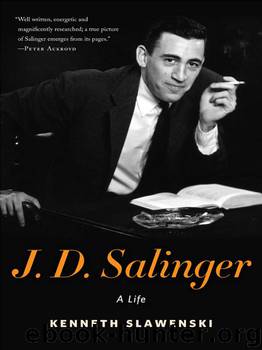J. D. Salinger: A Life by Kenneth Slawenski

Author:Kenneth Slawenski
Language: eng
Format: mobi, epub
Tags: Salinger, J. D, 20th century, General, Literary, American - 20th century, American, Literary Criticism, Authors, Biography & Autobiography, Biography
ISBN: 9781400069514
Publisher: Random House
Published: 2011-01-25T10:00:00+00:00
—John Updike, 19741
In creating the intimacy between Holden Caulfield and readers of The Catcher in the Rye, Salinger employed the lesson taught to him by Whit Burnett in 1939 when Burnett read William Faulkner without coming “between the author and his beloved silent reader.”2 Like countless other Americans, Faulkner himself was experiencing that same intimacy during the summer of 1951, glimpsing within the pages of Catcher a reflection of himself. “Salinger’s Catcher in the Rye,” he remarked, “expresses so completely what I have tried to say.” Yet, by experiencing Holden’s character through the echo of his own reflection, Faulkner saw the journey of Holden Caulfield as an unredeemed misery. “His tragedy,” Faulkner felt, “was that when he attempted to enter the human race, there was no human race there.”3
William Faulkner’s appreciation of Salinger’s novel brought full circle an inspiration that he himself had unwittingly catapulted. But his interpretation also foreshadowed the predicament that Salinger now faced: different people were drawn to Catcher for different reasons. By virtue of Holden’s character being so absorbing and because the novel allowed so many interpretations, readers were anxious for its meaning to be clarified or to have their personal sensation of it confirmed. In the attempt, it was only natural that they would seek out the author himself. After all, Holden seemed to be talking about Salinger when he declared that after finishing a good book “you wish the author that wrote it was a terrific friend of yours and you could call him up on the phone whenever you felt like it.”4 Many readers took this line to be an open invitation. Nothing could have been farther from the truth.
In reality, Salinger hated every moment of the celebrity that now enclosed him. “It’s a goddamn embarrassment, publishing,” he moaned. “The poor boob who lets himself in for it might as well walk down Madison Avenue with his pants down.”5 Impatiently, he waited for book sales to subside and his notoriety to fade, but the furor over Catcher showed no sign of abating. By the end of the summer the novel was already in its fifth printing and climbing the New York Times best-seller list.
Still Salinger held out hope that he could resume a normal life. As late as February 1952, although Catcher stubbornly remained on the book charts, he insisted that he could put the novel’s publication behind him and retrieve the past.* In an interview granted that month to the Daily Mirror in England, he was optimistic. “The fact is,” he stated prematurely, “I feel tremendously relieved that the season for the success of The Catcher in the Rye is over. I enjoyed a small part of it but most of it I found hectic and professionally and personally demoralizing. Let’s say I’m getting good and sick of bumping into that blown-up photograph of my face on the back of the dust-jacket. I look forward to the day when I see it flapping against a lamp post, in a cold, wet Lexington Avenue wind.
Download
This site does not store any files on its server. We only index and link to content provided by other sites. Please contact the content providers to delete copyright contents if any and email us, we'll remove relevant links or contents immediately.
| Africa | Asia |
| Canadian | Europe |
| Holocaust | Latin America |
| Middle East | United States |
Fanny Burney by Claire Harman(26526)
Empire of the Sikhs by Patwant Singh(22974)
Out of India by Michael Foss(16791)
Leonardo da Vinci by Walter Isaacson(13181)
Small Great Things by Jodi Picoult(7019)
The Six Wives Of Henry VIII (WOMEN IN HISTORY) by Fraser Antonia(5394)
The Wind in My Hair by Masih Alinejad(5033)
A Higher Loyalty: Truth, Lies, and Leadership by James Comey(4843)
The Lonely City by Olivia Laing(4747)
The Crown by Robert Lacey(4722)
Millionaire: The Philanderer, Gambler, and Duelist Who Invented Modern Finance by Janet Gleeson(4374)
The Iron Duke by The Iron Duke(4291)
Papillon (English) by Henri Charrière(4195)
Sticky Fingers by Joe Hagan(4100)
Joan of Arc by Mary Gordon(4013)
Alive: The Story of the Andes Survivors by Piers Paul Read(3967)
Stalin by Stephen Kotkin(3875)
Aleister Crowley: The Biography by Tobias Churton(3586)
Ants Among Elephants by Sujatha Gidla(3417)
